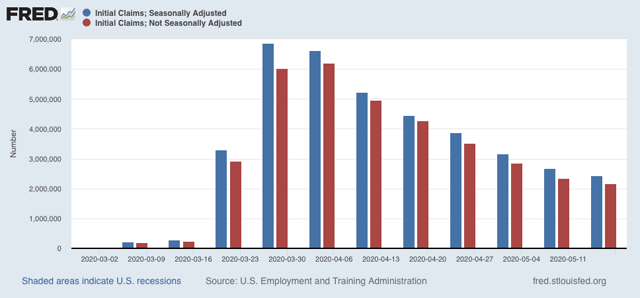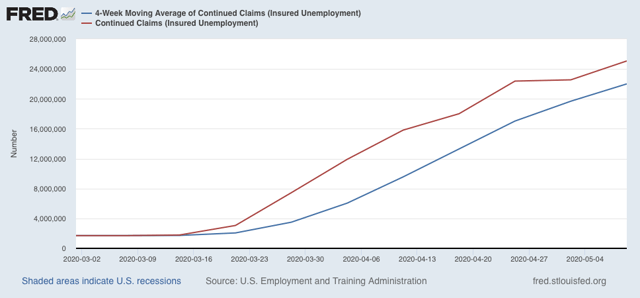- by New Deal democrat
Now that there is more than one month of data from initial and continuing jobless claims since the coronavirus lockdowns started, we can begin to trace whether the economic impacts of the virus are being contained, or are continuing to spread out into further damage.
Nine weeks in, it appears that, insofar as employment is concerned, the damage is continuing to spread.
First, let’s look at initial jobless claims both seasonally adjusted (blue) and non- seasonally adjusted (red). The non-seasonally adjusted number is of added importance since seasonal adjustments should not have more than a trivial effect on the huge real numbers:

There were 2.174 million new claims, which after the seasonal adjustment became 2.438 million. This is a slight decline from last week’s number which was revised down to 2.687 million.
By now, virtually all of the people laid off due to the initial lockdowns in March and early April should have already applied for benefits. Further, last week was the second week after some States “reopened.” Thus these new claims are almost certainly primarily represent the spreading second-order impacts of the coronavirus shutdowns. In other words, this is evidence that new economic damage have continued to spread, and in a very large way.
Next, looking at continuing claims, which lag one week behind, both the non-seasonally adjusted number (red), and the less important seasonally adjusted number (blue) rose:

This tells us that, as of two weeks ago, there were not enough callbacks to work to offset the spreading new damage. If “reopening” leads to a significant new upturn in cases - something that may have begun in the past week - this will only get worse.
Bottom line: confining my comments strictly to the economy, while there have been significant or small rebounds in many of the series, the news on employment is not just bad, but it is still getting worse, albeit getting worse at a slower rate.